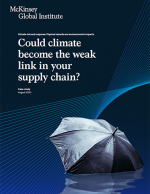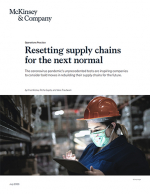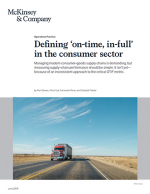Could Climate Become The Weak Link In Your Supply Chain?
Supply chains and the infrastructure that supports them are designed for a stable climate, but as hazards evolve, it will be necessary to increase investment in adaptation, possibly at the expense of efficiency.
Climate Risk, Response, and Diagnostics
Risk diagnostics should be a major consideration for many players.
To successfully increase climate resilience, supply chain managers should first identify which of their suppliers (and their suppliers’ suppliers, and so on) are critical for business continuity, and what level of climate hazard these suppliers face.
Based on this information, an assessment can be made of where the largest risks lie in the supply chain from climate-related hazards.
This is a non-trivial task: the many possible permutations and layers in supply chains, the interdependencies of supply and demand, and the vast optionality of different adaptation measures at different points all create significant complexity.
Investments in digital analytics to understand data-driven simulations of alternate adaptation and risk scenarios may be beneficial. No-regret moves include:
- Identifying and prioritizing key risks, having adequate insurance coverage
- Setting up a war room and practicing simulations, and
- Closer collaboration between suppliers and buyers.
While any individual action is insufficient to eliminate the supply disruption risk entirely, a combination of adaptive actions can limit the risk significantly.
We find the significant potential for many industries to adapt in the next decade, and indeed this is already underway in some areas, including from public authorities, suppliers in high-hazard locations, and customers in downstream sectors.
For example, a leading global manufacturing conglomerate has increased stocks of critical inputs and has entered contingency plan agreements with suppliers to ensure they get an allocation of available supplies following a disaster.
A global agricultural business is diversifying its raw material sourcing across different geographies and its industrial activities across crops, to reduce the impact of local crop failures (for example, from unusual local weather conditions).
Introduction to Case Studies
Our cases show that the direct risk from climate hazards is determined by the severity of the hazard and its likelihood, the exposure of various “stocks” of capital (people, physical capital, and natural capital) to these hazards, and the resilience of these stocks to the hazards (for example, the ability of physical assets to withstand flooding).
We typically define the climate state today as the average conditions between 1998 and 2017, in 2030 as the average between 2021 and 2040, and in 2050 between 2041 and 2060.
Through our case studies, we also assess the knock-on effects that could occur, for example to downstream sectors or consumers.
What’s Related




Favorites





